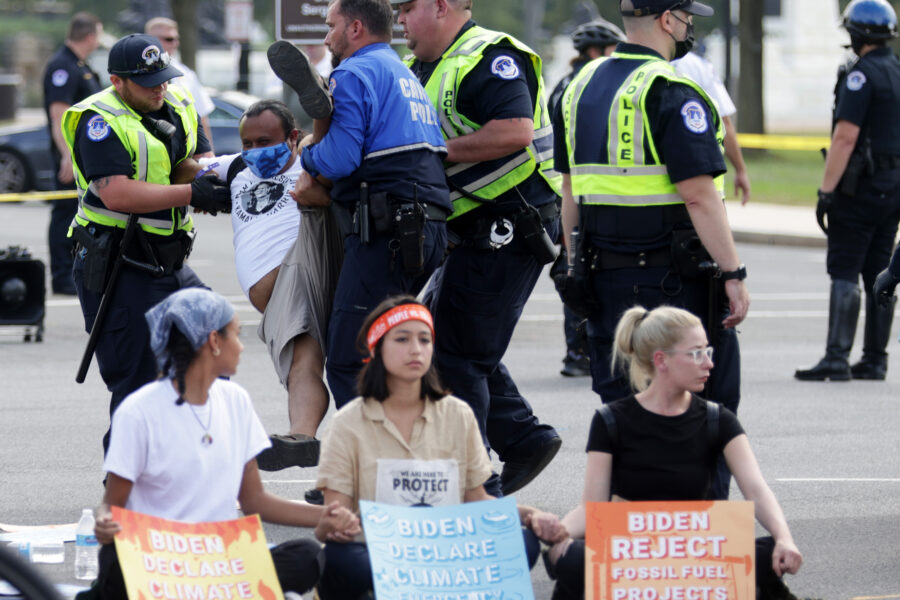In Push to Meet Maryland’s Ambitious Climate Commitments, Moore Announces New Executive Actions
Maryland Gov. Wes Moore Tuesday issued a wide-ranging executive order on reducing climate pollution, directing the Maryland Department of the Environment and other agencies to develop a host of initiatives including a zero-emission heating equipment standard to reduce pollution and improve ambient air quality inside homes.
Announcing his plan at the Henderson-Hopkins community school in East Baltimore, Moore tasked the Maryland Energy Administration with establishing a framework to achieve 100 percent clean energy by 2035 and directed the Maryland Department of Transportation to undertake several measures to promote clean transportation.
“Today’s order calls on every single state agency to submit a Climate Implementation Plan (CIP),” Moore said, adding that each agency should spell out how their actions would help meet Maryland’s goals of cutting emissions by 60 percent by 2031 and achieving net-zero emissions by 2045.
The executive order sets a Nov. 1 deadline for all agency submissions to the governor, in consultation with the Department of the Environment (MDE).
We’re hiring!
Please take a look at the new openings in our newsroom.
See jobsEach plan is required to spell out specific steps, timelines and resources to implement actions in concert with Maryland’s Climate Pollution Reduction Plan and the Climate Solutions Now Act of 2022.
In addition to stating their top priorities for the upcoming year, the order requires state agencies to demonstrate how they will address the disproportionate impacts of climate change on underserved communities.
“We need to make sure that in this transition to clean energy, that we leave no one behind. This is not just a motto for this administration. This is a governance philosophy,” Moore said.
He designated the MDE as the lead agency to oversee the implementation of the climate actions.
“Secretary [Serena] McElwain and her team will submit an annual report directly to me on progress that each agency is making, and the secretary will also chair a new sub-cabinet on climate, which will be vice chaired by our chief sustainability officer, Meghan Conklin,” Moore said.
In a March interview, Conklin, Maryland’s first chief sustainability officer, told Inside Climate News that she will also serve on the Chesapeake Bay Cabinet, assisting the administration in implementing climate-related policies, regulations and programs.
In addition to the new clean heat standard for ambient air, the executive order requires the MDE to propose a plan to modify the Regional Greenhouse Gas Initiative (RGGI) to establish a new regional cap for carbon dioxide emissions for power plants that is aligned with Maryland and partner states’ 100 percent clean energy goals.
RGGI is a market-based effort among 12 Northeastern and mid-Atlantic states to cap and reduce CO2 emissions from the power sector.
“The new clean air standards will reduce emissions of harmful pollutants, including nitrous oxide, small particulate matter and ozone pollution. The regulations are also expected to increase adoption of highly efficient heat pumps, which provide affordable, reliable heating and cooling year round while reducing health-harming air pollution,” said Emily Scarr, director of consumer advocacy group PIRG Maryland.
“Burning fossil fuels in our buildings is a major source of greenhouse gas emissions in Maryland,” said Josh Tulkin, director of the Sierra Club’s Maryland chapter. “By developing zero-emission heating equipment standards this year, Maryland can make a measurable dent in climate pollution while delivering cleaner, healthier air for residents.”
Ruth Ann Norton, president & CEO of the Green & Healthy Homes Initiative, said that Moore’s announcement cements Maryland’s legacy as a climate leader and will create more equitable access to climate and health resources. “Phasing in zero-emission heating equipment standards, coupled with policies that build healthier, more affordable homes, will provide urgent relief in the form of cleaner, healthier air for low-income families and a future where all Marylanders can thrive,” she said.
Moore’s executive order, “Leadership by State Government: Implementing Maryland’s Climate Pollution Reduction Plan,” says that “achieving an equitable transition to a clean energy future could require a public sector investment of approximately $1 billion annually.”
Finding that much money for the clean energy transition could be particularly challenging for the Moore administration, which is troubled by a cash shortfall of roughly $1.1 billion and a budgetary hole of $761 million for fiscal year 2025.
At the beginning of the last General Assembly session earlier this year, environmental advocates expected the administration to put its weight behind spending bills to power its climate plans. Examples included a bill which sought to establish a $900 million Climate Change Adaptation and Mitigation Fund by making oil and gas companies pay for their pollution in addition to a cap-and-invest program, which would have generated $300 million for climate initiatives.
But none of these proposals were backed by the administration and failed to pass, disappointing the advocates. The uncertain future of offshore wind energy projects—an 8.5 gigawatt legally-binding commitment by Maryland—further hobbled prospects of achieving the clean energy targets.
Advocates said Tuesday’s executive order gave fresh impetus to the state’s efforts to chart the course away from fossil fuels by aligning state agencies’ policies and actions with Maryland’s clean energy commitments.
Share this article
Disclaimer: The copyright of this article belongs to the original author. Reposting this article is solely for the purpose of information dissemination and does not constitute any investment advice. If there is any infringement, please contact us immediately. We will make corrections or deletions as necessary. Thank you.







